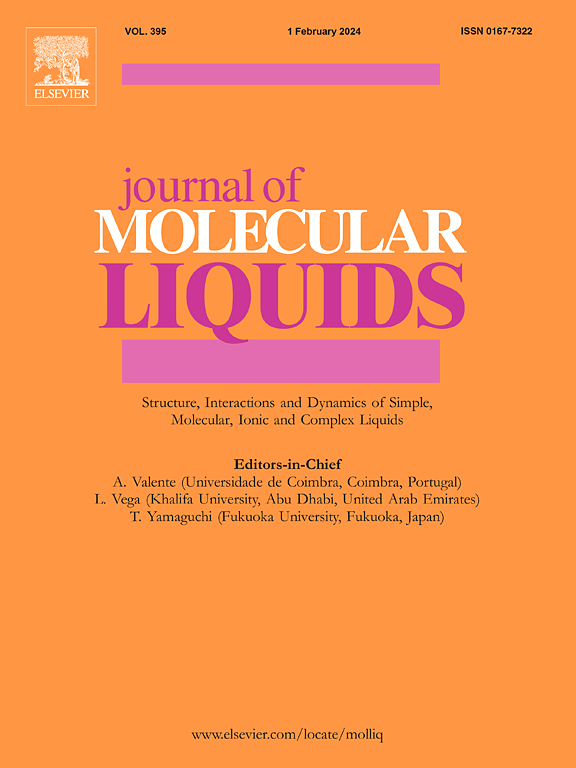Effect of CsPbBr3 perovskite quantum dots on molecular alignment, dielectric and memory effect of a cyanobiphenyl based liquid crystal
IF 5.3
2区 化学
Q2 CHEMISTRY, PHYSICAL
引用次数: 0
Abstract
We demonstrate here the impact of doping of CsPbBr3 perovskite quantum dots (CsPbBr3 PQDs, diameter ∼ 7–9 nm) on the molecular alignment, dielectric and memory effect of nematic (N) and smectic A (SmA) phases of a thermotropic liquid crystal material, namely 4-octyl-4′-cyanobiphenyl (8CB) using polarising optical microscope and dielectric spectroscopy. There is no significant change in the alignment of N and SmA phases of 8CB by the doping of CsPbBr3 PQDs, except the color change attributed to the tuned birefringence of 8CB by PQDs. The slight aggregation of PQDs is observed in both LC phases of 1.0 wt% CsPbBr3 PQDs-8CB composite and which could be due to the higher dopant concentration in 8CB matrix. The dielectric parameters (permittivity, loss and anisotropy) of N and SmA phases of 8CB are found to be strongly dependent on the dopant concentration. The dielectric anisotropy (Δε′) of 8CB is observed to decrease with increase in the dopant concentration except 0.5 wt% composite. The temperature dependent Δε′ further confirms that there is no significant change in the clearing temperature of composites as compared to pure 8CB. The short axis molecular relaxation observed in both N and SmA phases of pure 8CB and its composites on the application of 40 V bias. The slight spectral shift of this relaxation towards lower frequency side and decrease in the amplitude of ɛ″ in both SmA and N phases of 1.0 wt% composite as compared to the pure 8CB and composites with concentration lower than 1.0 wt%. The partial memory effect is observed in SmA phase of pure 8CB through voltage-dependent dielectric permittivity and cross-polarised optical textures. The observed memory effect in SmA phase is found to improve with increase in the concentration of PQDs. Most importantly, the complete memory effect is observed in SmA phase of 1.0 wt% CsPbBr3 PQDs-8CB composite. This could be attributed to the holding of smectic layers reorientation achieved at 40 V bias for longer duration after the removal of 40 V bias voltage. A point to be noted here is that no memory effect is observed in the N phase of pure 8CB and its composites with CsPbBr3 PQDs. Our results on CsPbBr3 PQDs-8CB composites are clearly indicative towards their potential applications in next generation tunable electro-optical and long-lasting soft memory devices. Moreover, results on these composites would also serve as the testbeds for theoretical and computational studies to explore the mechanism responsible for tunable optical, dielectric and electro-optical properties of 8CB by the dopant CsPbBr3 PQDs.
CsPbBr3 包晶量子点对氰联苯基液晶的分子排列、介电和记忆效应的影响
我们在此利用偏振光学显微镜和介电光谱法证明了掺杂 CsPbBr3 包晶量子点(CsPbBr3 PQDs,直径 ∼ 7-9 nm)对热致性液晶材料 4-辛基-4′-氰基联苯(8CB)的向列相(N)和 Smectic A 相(SmA)的分子排列、介电和记忆效应的影响。掺入 CsPbBr3 PQDs 后,8CB 的 N 相和 SmA 相的排列没有明显变化,只是颜色发生了变化,这是因为 PQDs 调整了 8CB 的双折射。在 1.0 wt% CsPbBr3 PQDs-8CB 复合材料的两个 LC 相中都观察到了 PQDs 的轻微聚集,这可能是由于 8CB 基体中的掺杂浓度较高所致。研究发现,8CB 的 N 相和 SmA 相的介电参数(介电常数、损耗和各向异性)与掺杂剂浓度密切相关。除了 0.5 wt%的复合材料外,8CB 的介电各向异性(Δε′)随着掺杂剂浓度的增加而减小。与温度相关的 Δε′ 进一步证实,与纯 8CB 相比,复合材料的清除温度没有显著变化。在施加 40 V 偏置时,在纯 8CB 及其复合材料的 N 相和 SmA 相中都观察到了短轴分子弛豫。与纯 8CB 和浓度低于 1.0 wt%的复合材料相比,1.0 wt%的复合材料中 SmA 和 N 相的这种弛豫的光谱向低频侧轻微偏移,ɛ″ 的振幅减小。通过电压相关介电常数和交叉偏振光学纹理,在纯 8CB 的 SmA 相中观察到了部分记忆效应。在 SmA 相中观察到的记忆效应随着 PQDs 浓度的增加而增强。最重要的是,在 1.0 wt% CsPbBr3 PQDs-8CB 复合材料的 SmA 相中观察到了完全的记忆效应。这可能是因为在移除 40 V 偏置电压后,在 40 V 偏置电压下实现的胶层重新定向保持了更长的时间。值得注意的一点是,在纯 8CB 及其与 CsPbBr3 PQDs 复合材料的 N 相中没有观察到记忆效应。我们对 CsPbBr3 PQDs-8CB 复合材料的研究结果清楚地表明了它们在下一代可调电光和长效软存储器件中的潜在应用。此外,这些复合材料的研究结果还将作为理论和计算研究的试验平台,以探索掺杂 CsPbBr3 PQDs 使 8CB 具有可调光学、介电和电光特性的机理。
本文章由计算机程序翻译,如有差异,请以英文原文为准。
求助全文
约1分钟内获得全文
求助全文
来源期刊

Journal of Molecular Liquids
化学-物理:原子、分子和化学物理
CiteScore
10.30
自引率
16.70%
发文量
2597
审稿时长
78 days
期刊介绍:
The journal includes papers in the following areas:
– Simple organic liquids and mixtures
– Ionic liquids
– Surfactant solutions (including micelles and vesicles) and liquid interfaces
– Colloidal solutions and nanoparticles
– Thermotropic and lyotropic liquid crystals
– Ferrofluids
– Water, aqueous solutions and other hydrogen-bonded liquids
– Lubricants, polymer solutions and melts
– Molten metals and salts
– Phase transitions and critical phenomena in liquids and confined fluids
– Self assembly in complex liquids.– Biomolecules in solution
The emphasis is on the molecular (or microscopic) understanding of particular liquids or liquid systems, especially concerning structure, dynamics and intermolecular forces. The experimental techniques used may include:
– Conventional spectroscopy (mid-IR and far-IR, Raman, NMR, etc.)
– Non-linear optics and time resolved spectroscopy (psec, fsec, asec, ISRS, etc.)
– Light scattering (Rayleigh, Brillouin, PCS, etc.)
– Dielectric relaxation
– X-ray and neutron scattering and diffraction.
Experimental studies, computer simulations (MD or MC) and analytical theory will be considered for publication; papers just reporting experimental results that do not contribute to the understanding of the fundamentals of molecular and ionic liquids will not be accepted. Only papers of a non-routine nature and advancing the field will be considered for publication.
 求助内容:
求助内容: 应助结果提醒方式:
应助结果提醒方式:


